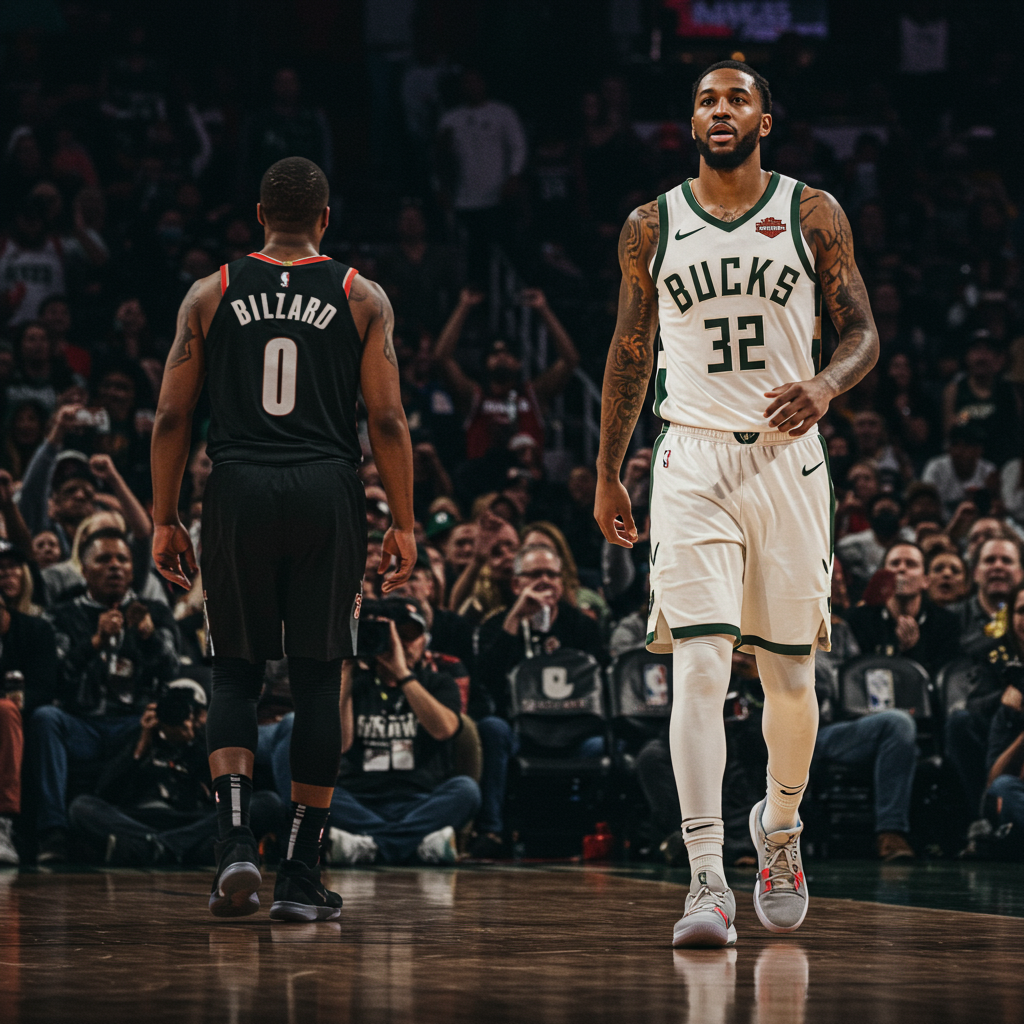In a stunning maneuver shaking the NBA landscape, the Milwaukee bucks are reportedly waiving All-Star guard Damian Lillard. This aggressive move aims to clear crucial salary cap space required to sign coveted free agent center Myles Turner away from the Indiana Pacers. Multiple sources confirm the decision, which signifies a dramatic shift for a Bucks team determined to remain an Eastern Conference powerhouse.
The surprising transaction is driven primarily by Lillard’s recent injury. He sustained a torn Achilles tendon late last season and is expected to miss the majority of the upcoming campaign. Lillard’s contract carried a substantial $113 million obligation over the next two years. By waiving him, the Bucks can utilize the “stretch provision,” a salary cap mechanism that allows teams to spread a player’s remaining guaranteed salary over a period up to twice the remaining contract years plus one. In Lillard’s case, this means his significant salary burden will be amortized over the next five seasons, drastically reducing its immediate impact on Milwaukee’s cap sheet. This decision marks the largest stretch-waive contract in NBA history.
Why the Bucks Targeted Myles Turner
Bucks General Manager Jon Horst has a well-earned reputation for making bold, unexpected moves aimed at keeping superstar Giannis Antetokounmpo in a competitive environment. Lillard’s severe injury was seen as a major blow, potentially derailing the team’s hopes of contending for a top playoff seed next season. Acquiring Myles Turner represents a direct response to this challenge, instantly reconfiguring the roster around Giannis.
Turner, a 29-year-old center, offers a highly talented and stylistically similar replacement for long-time starter Brook Lopez, who has reportedly signed with the Los Angeles Clippers. Like Lopez, Turner provides elite rim protection, averaging two blocks per game. Crucially, he also stretches the floor offensively, shooting an impressive 39.3 percent from three-point range on 5.2 attempts per contest. This combination of skills makes him an ideal pick-and-pop or pick-and-roll partner for Antetokounmpo, while maintaining valuable defensive presence in the paint. Turner is also slightly younger than Giannis, aligning their primes for the foreseeable future.
Securing Turner from the Indiana Pacers holds additional strategic value. The Pacers eliminated the Bucks in the first round of the playoffs in each of the last two seasons and reached the Eastern Conference Finals most recently. Taking a key player from a recent playoff rival weakens them while strengthening Milwaukee. For the Pacers, losing their starting center without receiving any assets in return is a significant blow, reportedly leaving them scrambling for a replacement. This outcome may be linked to Indiana’s financial considerations, specifically aiming to avoid the luxury tax.
Navigating the Complex Cap Mechanics
Executing this move required intricate salary cap gymnastics. The core mechanic involves waiving Damian Lillard and applying the stretch provision to his remaining salary. Beyond Lillard, the Bucks made several other crucial moves to generate the necessary cap room, aiming for approximately $24 million to sign Turner.
They reportedly re-signed several key free agents without using their non-taxpayer midlevel exception (NTMLE). Taurean Prince returned on a two-year, $7.1 million contract with a player option in the second year. Gary Trent Jr. also signed a two-year deal worth $7.5 million, including a player option in the second year. Kevin Porter Jr. was brought in using the rarely utilized biannual exception, agreeing to a two-year deal starting at $5.39 million. These signings kept the Bucks below the luxury tax and the first apron, which they are hard-capped at due to the Porter Jr. contract. Importantly, they retained their full $14.1 million NTMLE and early Bird rights on Ryan Rollins, maintaining future flexibility.
Even with these maneuvers, initial reports suggested the Bucks had around $19.6 million in cap room. To bridge the gap to the needed $24 million for Turner, they will likely need to shed additional salary. Pat Connaughton’s $9.3 million salary is the most probable candidate to be moved via trade to create the final chunk of space required to finalize Turner’s four-year, $107 million agreement.
Lillard’s Unprecedented Freedom
While being waived, especially while injured, might seem like a negative outcome, sources close to Damian Lillard describe him as “elated” by the decision. This unexpected turn of events places him in an incredibly unique position for an All-Star caliber player. Because his large remaining salary is guaranteed and being paid by the Bucks through the stretch provision, Lillard effectively becomes an unrestricted free agent with financial security.
He can now prioritize joining a contending team solely based on basketball fit and championship aspirations, without the need for a large new contract. Any salary he signs for with a new team will offset a portion of what the Bucks owe him, but it does not reduce his overall income. This level of financial freedom, coupled with the ability to choose his next environment, is virtually unprecedented in professional sports for a player of his stature. Lillard’s agent characterized it as an “incredible opportunity.”
This situation allows Lillard to potentially rehabilitate his Achilles injury on his own timeline and location, perhaps closer to his children, addressing some of the off-court frustrations he reportedly experienced in Milwaukee. Before his injury, there were already whispers that Lillard and the Bucks might discuss a change of scenery due to on-court fit issues and personal circumstances. Now, he departs Milwaukee with maximum control over his future. Contending teams reportedly reached out almost immediately after the news broke. The immediate question for Lillard is whether to sign with a team soon to facilitate rehab under their care or wait until next summer to fully assess his options once healthy.
Impact on the Bucks and Eastern Conference
The acquisition of Myles Turner fundamentally alters the Milwaukee Bucks’ identity. Replacing Lopez with Turner means a slightly different defensive approach, though both excel at protecting the paint and shooting from deep. Turner’s defensive versatility and shooting could arguably provide a better fit alongside Giannis in the modern NBA, offering more dynamic possibilities on both ends of the court. The team is banking on this roster reconfiguration to propel them back into contention for a top seed in the competitive Eastern Conference.
However, the move is not without potential drawbacks. Waiving and stretching Lillard’s contract represents a significant long-term cap commitment that limits future flexibility. Furthermore, reports suggest Giannis Antetokounmpo is “not pleased” with the decision to part ways with Lillard. Maintaining a positive relationship with their franchise cornerstone is paramount, and any reported friction could create uncertainty down the line. Despite this, the Bucks have successfully retained other key pieces in Prince, Trent Jr., and Porter Jr., adding depth around their core of Giannis and now Turner. This strategic pivot reflects the high stakes involved in building a championship team around a superstar and the difficult choices faced when injuries derail initial plans.
The ripple effects extend across the league. The Pacers are left searching for a center. Other contenders now view Lillard as a uniquely appealing free agent target, regardless of his immediate health. The move underscores the current NBA landscape where cap space is tight, significant roster changes are often achieved through trades or creative cap maneuvers like the stretch provision, and teams are positioning themselves not just for the upcoming season but potentially for a stronger free agent class in 2026.
Frequently Asked Questions
Why did the Milwaukee Bucks waive Damian Lillard?
The Milwaukee Bucks waived Damian Lillard primarily because he suffered a torn Achilles tendon and is expected to miss most of the next season. This injury severely impacted the team’s immediate championship aspirations. By waiving Lillard, who had $113 million remaining over two years, the Bucks could use the stretch provision. This maneuver frees up significant immediate salary cap space, allowing them to sign free agent center Myles Turner to a four-year, $107 million contract and reconfigure the roster to remain competitive around Giannis Antetokounmpo.
What is the “stretch provision” the Bucks used on Lillard’s contract?
The stretch provision is an NBA salary cap rule allowing teams to release a player and spread their remaining guaranteed salary over a period longer than the original contract term. The maximum stretch period is calculated as twice the number of remaining years plus one. Since Damian Lillard had two years left on his contract, the Bucks can stretch his remaining $113 million salary over five seasons (2 * 2 + 1 = 5). This dramatically reduces the amount of salary counting against the team’s cap in the short term, creating room for new signings like Myles Turner.
What does this move mean for the Bucks’ championship chances?
Acquiring Myles Turner is intended to improve the Bucks’ championship chances by replacing Brook Lopez with a younger, similarly skilled center who can stretch the floor (39.3% 3FG) and protect the rim (2 blocks per game) alongside Giannis Antetokounmpo. This roster change aims to make them a stronger contender for a top seed in the Eastern Conference, especially after Lillard’s injury significantly hampered their outlook. However, the long-term cap implications of stretching Lillard’s salary and potential reported dissatisfaction from Giannis Antetokounmpo add complexity and risk to the team’s future prospects.
Conclusion
The Milwaukee Bucks’ decision to waive Damian Lillard and sign Myles Turner is a high-stakes gamble. Driven by Lillard’s unfortunate injury and the strategic imperative to maintain a championship-caliber roster for Giannis Antetokounmpo, the move required complex cap gymnastics, including the largest stretch-waive contract in NBA history. While it lands them an elite two-way center in Turner and provides Damian Lillard with unprecedented freedom to choose his next destination, it also mortgages future cap flexibility and reportedly creates friction with their superstar. This bold transaction reshapes the Bucks, impacts the Pacers significantly, and adds a fascinating new dynamic to the Eastern Conference race and Damian Lillard’s Hall of Fame career path. The true success of this move will only be measured by its ability to deliver another NBA title to Milwaukee.



